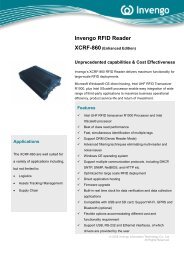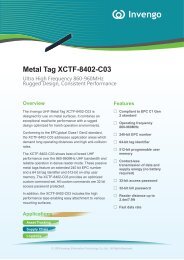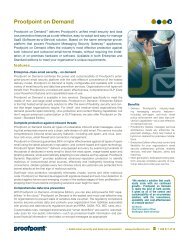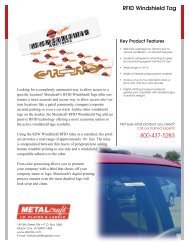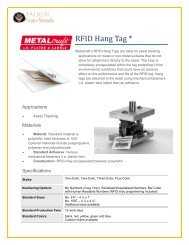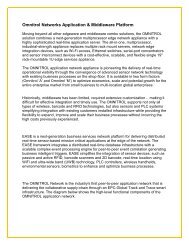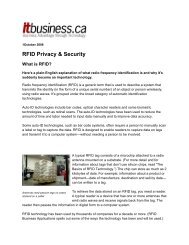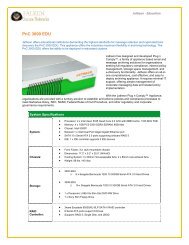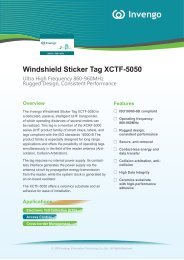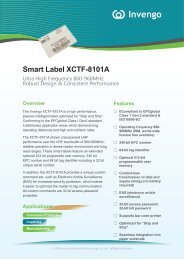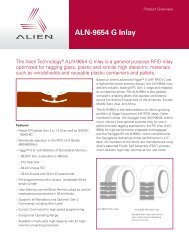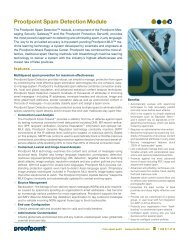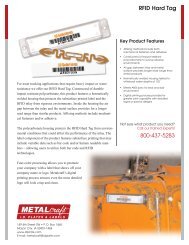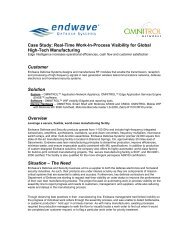The Benefits of RFID for Slab- and Coil-Logistics - Falken Secure ...
The Benefits of RFID for Slab- and Coil-Logistics - Falken Secure ...
The Benefits of RFID for Slab- and Coil-Logistics - Falken Secure ...
You also want an ePaper? Increase the reach of your titles
YUMPU automatically turns print PDFs into web optimized ePapers that Google loves.
<strong>The</strong>se key components are described in<br />
more detail in the following.<br />
6.2.1 Electronic Product Code (EPC)<br />
<strong>The</strong> Electronic Product Code (EPC) is a<br />
generic „license-plate“ type identifier<br />
that uniquely identifies any item in a<br />
supply chain. It is a simple, compact<br />
scheme that can generate an extremely<br />
large number <strong>of</strong> unique identifiers. <strong>The</strong><br />
scheme <strong>of</strong>fers a low barrier to entry<br />
since a company can embed existing<br />
serial numbers into the corresponding<br />
partition <strong>of</strong> the EPC. Even if this<br />
approach is not feasible given company<br />
st<strong>and</strong>ards, a single database table associating<br />
existing product IDs with EPC<br />
numbers would work to resolve the<br />
problem.<br />
length<br />
value<br />
Any EPC is made <strong>of</strong> six different<br />
sections (see Figure 20), each <strong>of</strong> which<br />
may vary in size, making the numbering<br />
scheme flexible <strong>and</strong> highly scalable:<br />
• <strong>The</strong> Header denotes the version <strong>of</strong> the<br />
EPC used, allowing <strong>for</strong> different EPCtypes<br />
<strong>and</strong> facilitating future extensibility<br />
<strong>of</strong> the scheme<br />
• <strong>The</strong> Filter Value indicates the level <strong>of</strong><br />
aggregation that the EPC represents<br />
(<strong>for</strong> example, an item, a box or a<br />
pallet)<br />
• <strong>The</strong> Partition designates the bit-position<br />
within the EPC at which the<br />
EPC Manager partition ends <strong>and</strong> the<br />
Object Class partition begins (while<br />
the total length <strong>of</strong> both partitions<br />
added together is constant, their size<br />
may vary depending on the Partition<br />
value)<br />
• <strong>The</strong> EPC Manager represents a<br />
specific company or domain (<strong>for</strong><br />
example, Perfect Steel)<br />
• <strong>The</strong> Object Class st<strong>and</strong>s <strong>for</strong> the type <strong>of</strong><br />
product being tagged (<strong>for</strong> example, a<br />
slab or coil)<br />
Header Filter Partition EPC Manager Object Class Serial Number<br />
8 bits 3 bits 3 bits 20-40 bits 24-4 bits 38 bits<br />
0011 0000 001<br />
5<br />
(decimal)<br />
8 <strong>The</strong> term „license plate“ is referring to a unique identifier<br />
being used as a “key” in order to obtain productrelated<br />
in<strong>for</strong>mation from an IT-system / database, as<br />
opposed to embedding the in<strong>for</strong>mation about the<br />
product together with the identifier (e.g. as part <strong>of</strong> a<br />
barcode or in an <strong>RFID</strong>-tag’s user memory).<br />
9 Discovery Services do not yet exist. <strong>The</strong>y are in the<br />
process <strong>of</strong> being defined by EPCglobal.<br />
4000001<br />
(decimal)<br />
001659<br />
(decimal)<br />
• <strong>The</strong> Serial Number corresponds to the<br />
actual item number (<strong>for</strong> example, the<br />
internal serial number <strong>of</strong> the slab or<br />
coil)<br />
Depending on the version indicated by<br />
the header, EPCs may vary in length,<br />
with 96 bits being the most common to<br />
date.<br />
36<br />
274877906943<br />
(decimal)<br />
A 96-bit EPC can be used <strong>for</strong> identification<br />
<strong>of</strong> up to 10 million product categories<br />
(object class) <strong>and</strong> over 274 billion<br />
unique instances (serial number) within<br />
each <strong>of</strong> those categories.<br />
This system provides more than enough<br />
room to uniquely identify any slab <strong>and</strong><br />
coil produced, even over a very long<br />
period <strong>of</strong> time.<br />
6.2.2 Discovery <strong>and</strong> Object Naming<br />
Services (DS <strong>and</strong> ONS)<br />
Discovery Services (DS) are a suite <strong>of</strong><br />
services that provide the link from products<br />
with <strong>RFID</strong> tags to product-related<br />
tracking in<strong>for</strong>mation residing on<br />
different IT-systems.<br />
<strong>The</strong> Object Naming Service (ONS) is a<br />
key part <strong>of</strong> the DS capability. It is a public<br />
service that can be used to find tracking<br />
data about a product from a registered<br />
EPCIS server.<br />
<strong>The</strong> ONS is very similar to DNS that used<br />
today to look up the associated host <strong>for</strong><br />
a particular Internet address or web site.<br />
With respect to the EPCglobal Network,<br />
ONS is an extremely rapid <strong>and</strong> reliable<br />
global database lookup service available<br />
to any product manufacturer.



